#grey parrot behavior
Explore tagged Tumblr posts
Text
youtube
Why African Grey Parrot Has Likes & Dislikes! (in Family members)
Have you ever noticed that your African Grey seems to have a "favorite" person? Or maybe there's someone they aren’t as fond of?
In this video, I explore why African Greys often pick specific family members to bond with and what signs reveal these preferences.
From affectionate behaviors to clear cues of discomfort, learn how your feathered friend communicates their likes and dislikes—and why they do it!
#tiktokparrot#african grey parrot care#africangrey#african grey parrot lifespan in captivity#cute birds#buying an african grey parrot#african grey behavior#african grey parrot#african grey#african grey lifespan#Mitthu#africangreyparrot#parrotlove#talking parrot#tiktok parrot#parrot talking english#parrot talking urdu#parrot talking pashto#parrot talking#indian ringneck#smart parrot#african grey parrot talking#african grey parrot likes#african grey talking#parrot that talks#african grey parrot behavior#grey parrot behavior#grey parrot likes#parrot behavior#grey parrot
0 notes
Text

212 notes
·
View notes
Text
TFW you're wasting your African Grey Parrot's 80-year lifespan with human stupidity for Likes.
Words cannot express how much I love this bird.
49K notes
·
View notes
Text
Essential Care Tips for African Gray Parrots
Read full story on-line: #CommonPetBirds #AfricanGrayParrot #ParrotCare #BirdHealth #PetBirds #FeatherCare #AvianHealth #BirdEnrichment #ParrotLovers #HealthyParrots #PetBirdCare #BirdsOfInstagram #AvianVeterinary #Birds #PetCareTips
Common Conditions of African Gray (Grey) Birds African Gray Parrots, known for their remarkable intelligence and vibrant personalities, require specialized care to thrive. Unfortunately, pet birds, including African Grays, can develop health issues when not provided with proper nutrition or care. Although many avian diseases can impact various species, some conditions are more prevalent in…
#African Gray#Animal Welfare#Aspergillosis#Avian Diseases#Bird Diet#Bird Enrichment#Bird Health#Feather Destructive Behavior#Grey Parrots#Nutritional Deficiencies#Parrot Care#Pet Birds#Psittacine Beak and Feather Disease#veterinary care
0 notes
Text
youtube
The Remarkable African Grey Parrot
Discover the incredible world of the African Grey Parrot, renowned for its intelligence and social nature!
Check out my other videos here: Animal Kingdom Animal Facts Animal Education
#Helpful Tips#Wild Wow Facts#African Grey Parrot#Parrot Intelligence#Talking Parrot#Parrot Training#African Grey Care#Exotic Birds#Parrot Speech#Bird Behavior#Pet Birds#Bird Training#African Grey Facts#Parrot Nutrition#Bird Enrichment#Grey Parrot Lifespan#Parrot Tricks#Bird Communication#Parrot Breeding#Parrot Vocalization#Bird Lovers#African Grey Talking#Smart Birds#Parrot Behavior#Parrot Bonding#Bird Health#African Grey Life#animal behavior#animal kingdom#animal science
0 notes
Text
Just Slapping Down Some More Attempts To Use Jinx Against Vi
**Spoilers For Arcane**
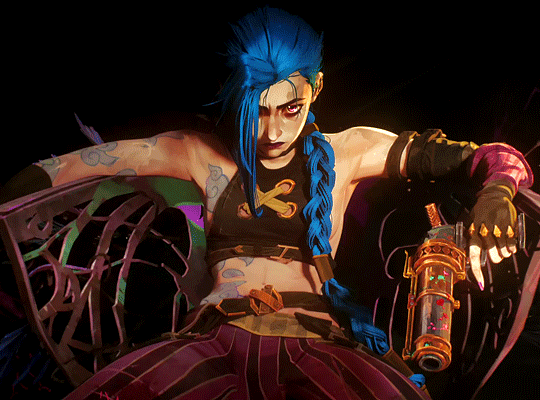
I don't want to make a whole big thing on this, because I've discussed it before as have many others. But I just saw like six or seven posts in a row parroting this weird idea that Jinx is somehow this golden standard that Vi has to live up to. I know these posts of mine sometimes draw some pretty harsh Jinx rhetoric. Let me be clear. I love this character. I think she has quite possibly the most tragic start of any of them and her battle to reclaim her soul and her mind over the course of the story is beautiful and heart wrenching. But man. Some of this stuff I read is just beyond baffling. This is NOT an anti-Jinx post. I am perhaps just too stupid to know how to address these points any other way when they are linking her specifically to other characters.
"You guys think Vi lost any sleep over the fact that Jinx honored Vander's legacy more than she ever did by becoming Zaun's hero, while Vi became as bad as Silco using gas to subdue her enemies?"
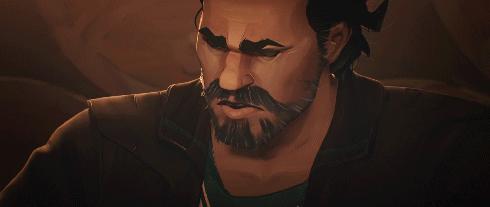
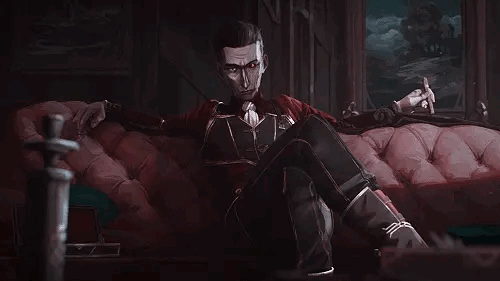
Jinx:
Integral part of Silco's operation pushing shimmer into Zaun
Attacked the council murdering three councilors bringing wrath of Piltover down
Unleashes the grey on all of Piltover indiscriminately
Lived in hiding with Isha during the occupation
Was made "The Symbol" because she was who Caitlyn was hunting and the Zaunites were desperate for something to believe in. It isn't because Jinx was a freedom fighter. The show confirmed multiple times over she did not participate before Act 2 picks back up.
Only goes to Stillwater for Isha.
Vi:
Part of team that destroys Chem-Barons (agents loyal to silco) and Shimmer (drug silco unleashed) which Ekko confirms are massive risks to Undercity
Part of team that uses the grey in strikes that are confirmed to be strategic to a pin-point per Amanda Overton.
More Like Silco?........ really?.......
2. "How do you guys think Vi felt leaving her two youngest surviving siblings behind on that bridge to fight while she ran away with her new Enforcer girlfriend?"-
Vi says goodbye as Caitlyn and Ekko crossing bridge
Marcus shoots Ekko and moves to attack Caitlyn
Jinx blows the ever loving shit out of the bridge
Vi runs back to help
Jinx wigs out and tries to kill Vi and Caitlyn
EKKO TELLS THEM TO RUN
3. Some mellow-dramatic wording with some images of little Vi protecting Powder and then angry Jinx looking at Enforcer Vi saying something like: "You used to promise to protect me from monsters. Then you became one" (wish i'd saved it).
A- Not sure she's in a position to judge:
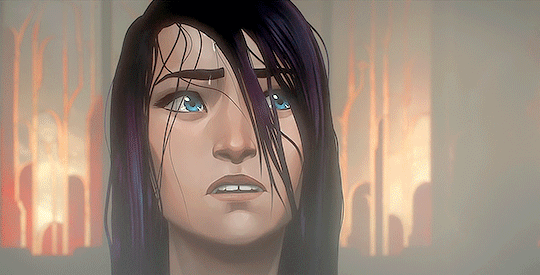
B- Why are they going down there anyway? Of right lol I remember:

4. "Never thought my sister would turn blue belly".
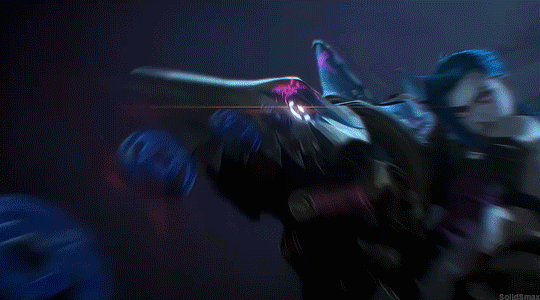
This is frequently used as a "oooohhh get her Jinx" moment. Shortly followed by Jinx justifying her orphaning of children because she's orphaned herself plenty, all taking place in the venue she's chosen to die in. Perhaps We shouldn't be taking her word as gospel here? Maybe?
Honorable mention: "I busted half of zaun out of stillwater while you were passed out in the bottom of a mug!" (paraphrased)- Like I said above. Ignored the occupation until Isha needed her. And Vi was in a just sort of suicidal spiral because of everything that happened to her including Jinx' behavior among other things.
70 notes
·
View notes
Text
Alagaësia Lore And Headcanons Series, Part 1: The Ra'zac and Lethrblaka
Not sure how exactly this series would be structured just yet, but in this post I will try to compile all the information we have on the Ra'zac and my personal headcanons about the species
-mod Mist
Appearance and Behavior
The species has three known forms - eggs, which are blue-black and "pitted like sandstone", the "pupae" - the Ra'zac, and the adults, the Lethrblaka. The existence of a fourth form is strongly implied (more on that later).
The Ra'zac have a vaguely humanoid bipedal posture with hunched backs. Though distinctly strange, they seem to be able to fool humans for quite long - the imperial soldiers under their authority in Eldest must have worked with them for at least weeks and did not seem to recognize them as non-humans.
Their appearance is probably best described in Eldest, p. 185: "A hideous, tortured face screamed at him. The skin was shiny black, like a beetle carapace. The head was bald. Each lidless eye was the size of his fist and gleamed like an orb of polished hematite; no iris or pupil existed. In place of a nose, mouth, and chin, a thick beak hooked to a sharp point that clacked over a barbed purple tongue."
Another description comes from Inheritance (p. 196), of a newborn Ra'zac: "The Ra’zac had a deep, ridged chest that made it look as if its ribs were on the outside of its body, not the inside. The creature’s limbs were thin and knobby, like sticks, and its waist was narrower than any human’s. Each leg had an extra backward-bending joint, something that Eragon had never seen before, but which accounted for the Ra’zac’s unsettling gait. Its carapace appeared soft and malleable, unlike those of the more mature Ra’zac Eragon had encountered. No doubt it would harden in time."
The lethrblaka are much larger and winged, also described in detail in Eldest, p. 188: "Their bodies were naked and hairless—like newborn mice—with leathery gray skin pulled tight across their corded chests and bellies. In form they resembled starved dogs, except that their hind legs bulged with enough muscle to crush a boulder. A narrow crest extended from the back of each of their attenuated heads, opposite a long, straight, ebony beak made for spearing prey, and cold, bulbous eyes identical to the Ra’zac’s. From their shoulders and backs sprang huge wings that made the air moan under their weight."
This description, at least to me, strongly brings to mind old outdated art of pterosaurs that are often depicted as grey, emaciated bat-like monsters:
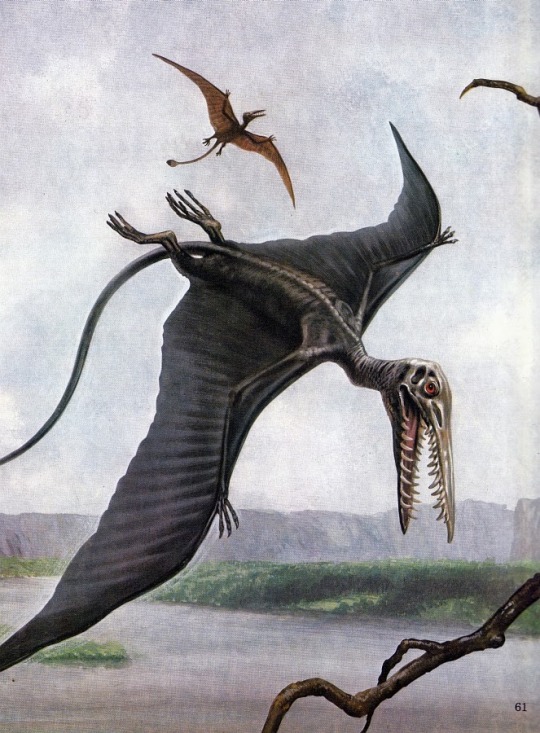
Rhamphorhynchus, W Francis Phillips
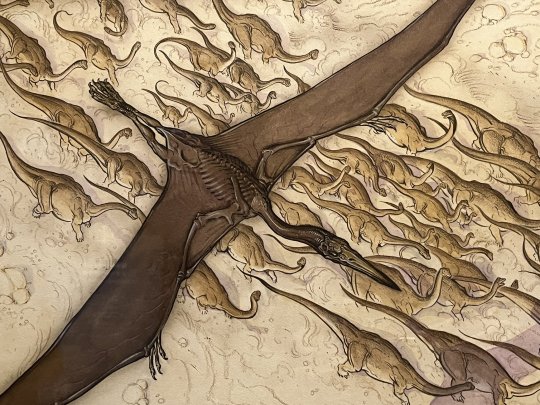
Quetzalcoatlus, William Stout
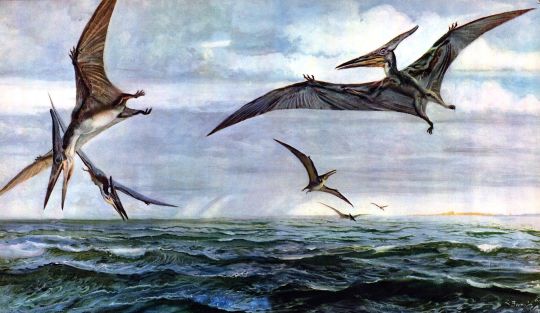
Pteranodon, Zdeněk Burian
According to Oromis, a Ra'zac will shed its exoskeleton on the first full moon of the twentieth year since its hatching (Eldest, p. 357). This would mean the Ra'zac also have a whole endoskeleton underneath their exoskeleton, or that the endoskeleton forms later and is possibly not made of bone.
The Ra'zac and Lethrblaka both feed on humans. While the Lethrblaka can feast on anything, the Ra'zac prefer human flesh. Based on the frequency of offerings by the priests of Helgrind, a Ra'zac needs to feed at least thrice a month (Brisingr, p. 5)
The Lethrblaka (and presumably the Ra'zac as well) have metallic blue-green blood. This sounds a lot like their blood is based on hemocyanin similar to insects, or some other similar substance (since hemocyanin is more transparent blue).
In Eragon (p. 64), Brom expresses bewilderment at the Ra'zacs' ability to replicate human speech. Since they have beaks, it is likely that they mimic speech the same way corvids and parrots do using their syrinx, which erases the issue of lacking lips. Though the Ra'zacs' voices are notably hissy (the way they are shown in dialogues), they likely struggle with sibilants or possibly replace these sounds with hisses as the nearest equivalent. Lethrblaka seem to lose the ability to mimic human language.
Their own langauge, which they share with lethrblaka, is a series of clicks, hisses, whistles, warbles and other sounds that are described as similar to either birds or insects.
In Brisingr, while debating making a pact with Eragon, the last Ra'zac makes a series of noises to himself. This may be either simply him talking to himself or alternatively, a way to express his emotional state. In other passages of the books, the Ra'zac react with hisses and screeches when angry or frustrated. It is possible that due to their hard exoskeleton, lidless eyes and stiff beaks, they make up for their ability to show their mood via facial expressions by expressing their feelings with different noises.
The Ra'zac and Lethrblaka seem to form close bonds among themselves - the Ra'zac show great respect to their parents, and the last Ra'zac seems to mourn his "hatchmate" enough to wish to disobey Galbatorix and avenge her death by killing Eragon.
Abilities
They are shown to be much stronger, faster and able to jump higher than humans. It's a question whether they are weaker, equal to or stronger than elves.
Their physical strength also makes them formidable swordfighters. It is possible they forge their own weapons, since their swords are described as unique in Alagaësia.
They have highly acute senses, most notably their eyesight, which lets them see perfectly under low-light conditions including near total darkness, and their sense of smell. Smell seems to be their primary sense, they are said to be able to track prey like a bloodhound and to never forget a smell.
They possess an "evil breath" that presumably contains toxic fumes that reduce the ability to think clearly, to the point of paralysis. This is the most effective on humans, barely affects dwarves and does not affect elves at all (Eldest, p. 357).
In multiple scenes they are also shown to have some kind of power over humans merely by looking at them. It is not certain whether this is strictly the effect of their poison breath or if they can use some sort of hypnosis.
The Ra'zac are described as "cunning and full of guile" (Eragon, p. 64) but "narrow-minded" (Eldest, p. 359). The Lethrblaka on the other hand "have all the intelligence of a dragon. A cruel, vicious, and twisted dragon" (same page).
They use Seithr oil, but it is unlikely that they produce it, since its creation requires magic (Eragon, p. 100).
Weaknesses - according to Oromis they are terrified of water since they cannot swim. Their highly developed eyesight also makes them vulnerable to sunlight and any other sharp light, which seems to be strong enough to cause physical pain.
Magic and True Names
The Ra'zac and Lethrblaka cannot use magic and their minds cannot be detected by magic users, as can be seen when they take Eragon and Saphira by surprise at Helgrind
There is also the reasons why they serve Galbatorix. According to the priest at Helgrind, he "stole their eggs and killed their young, and he forced them to swear fealty to him lest he eradicate their line entirely" (Inheritance, p. 192). Galbatorix prefers to control his servants through their True Names (such as Murtagh or the burrowing grubs from Vroengard he used to torture Nasuada), however, it seems that this was not the case since the last Ra'zac was able to disobey Galbatorix when attempting to kill Eragon in Brisingr.
All in all, some of the anomalous characteristics in terms of magic the Ra'zac possess are similar to the mutated species from Vroengard, such as the snalglí which seem to be immune to magical wards (Inheritance, p. 332)
This leads me to believe that the Ra'zac as a species somehow exist outside the framework of the Ancient Language and therefore lack True Names
We know that it is possible to give creatures a True Name (the sundavrblaka and íllgrathr, Inheritance, p. 532), but such thing is only possible using the Name of Names. Galbatorix is only shown controlling the grubs in Inheritance, after he has already learned the Name, which he had not known yet at the time of the death of the last Ra'zac in Brisingr.
Therefore, since they lack a True Name, are invisible to magic and cannot use it at all, it can be assumed they are not bound by the effects of the Ancient Language. This is somewhat supported by the fact that the name of their parents, Lethrblaka, is very clearly in the Ancient Language but does not seem to change anything about their ability (or inability) to be controlled. Ra'zac might also be "in the Ancient Language", but we will probably never know. In Eragon, p. 64, Brom says this about them: "They are called the Ra’zac. No one knows if that’s the name of their race or what they have chosen to call themselves." There is a chance that if they have indeed named themselves in the Ancient Language, the name would have no effect anyway.
Their existence outside the magic system of Alagaësia is also supported by what Saphira says first time Eragon mentions the Ra'zac: "Oaths betrayed, souls killed, eggs shattered! Blood everywhere. Murderers!" (Eragon, p. 44) As we know, for most races, even non-magic users, it is impossible to break an oath made in the Ancient Language. This might effectively make them the only sapient race capable of lying in the Ancient Language.
The Helgrind Cult
The cultists near Dras-Leona worship the Ra'zac and Lethrblaka, calling them the Old Ones and revering them by sacrificing their own flesh to them to "satisfy their desires". They also keep and protect the last (known) remaining Ra'zac eggs.
The high priest describes them as "the three-faced god—the hunters of men, the eaters of flesh, and the drinkers of blood". The three "faces" of the Ra'zac may be these listed three aspects of their species, or it may refer to their three distinct life forms.
According to Brom, the priests "spend much of their time arguing about which of Helgrind's three peaks is the highest and most important and whether the fourth - and lowest - should be included in their worship" (Eragon, p. 150).
They follow a certain Book of Tosk, presumably a human from the early history of human settlers in Alagaësia, a long enough time ago that the language of the Broddring Kingdom has evolved enough to make it incomprehensible to Eragon (Inheritance, p. 184)
Their goal seems to be to liberate the Ra'zac from Galbatorix and the Riders who have brought the species to near extinction shortly after their arrival to Alagaësia.
Origin of the Ra'zac
"They are the monsters in the dark, the dripping nightmares that haunt your race." “What manner of creatures are they?” “Neither elf; man; dwarf; dragon; furred, finned, or feathered beast; reptile; insect; nor any other category of animal.”
The most hints we get are from Oromis in Eldest (p. 357). He expresses the belief that they were the reason humans originally emigrated to Alagaësia from wherever their old homeland was.
From the way he describes them, the Ra'zac come off as almost otherworldly. Every species has relatives connected by a common ancestor. In Alagaësia even the dragons have distant cousins in the fanghur. The one-of-a-kind creatures of Vroengard seem to be easy to classify into categories of insects and birds. The Ra'zac seem to be the sole exception.
Oromis says "all areas where humans are weak, the Ra’zac are strong", and that they are the "nightmares that haunt your race". This is oddly specific. The Lethrblaka are said to hunt everything, but this might be simply a matter of finding enough prey to fuel their much larger bodies, or the Lethrblaka under Galbatorix's rule may have simply been instructed to seek other prey as not to draw attention to themselves.
These descriptions, the Ra'zacs' unusual abilities and complete separation from magic make it sound almost as if the Ra'zac were not a naturally evolved species, but rather created intentionally to hunt humans.
Theories
Who created the Ra'zac?
The Grey Folk - we have extremely little information on them except that they merged their language (the Ancient Language) with magic itself. They would certainly be capable of creating a brand new species. Problem is, the Grey Folk are said to have resided in Alagaësia (and were presumably native there) and after their magic ritual they faded away living among the "younger races" (it is not specified which ones, presumably elves and possibly humans after they settled Alagaësia). The Ra'zac arrived with the humans, so unless there were other Grey Folk living outside of Alagaësia this would make little sense.
The elves - they are said to have arrived to Alagaësia across the sea after a "terrible mistake" (this is a generally accepted fandom opinion, but I could not find any mention in the books). The problem with this theory is that elves and humans most likely do not come from the same place (elves are said to have arrived across the sea (Eragon p. 34), while humans came from "far to the south, beyond the Beor mountains" (p. 437))
Humans themselves - possibly an ancient civilization that intended to use them as population control/a force to keep citizens in line (this would make sense considering the juvenile Ra'zac are obedient to Galbatorix and "narrow-minded", meaning they would likely be easily trained), but the project went terribly wrong
Someone else
They are the result of random mutation similar to the creatures at Vroengard
What is their natural behavior?
The Ra'zac and Lethrblaka in the books are the last of their kind, their behavior and lifestyle cannot be considered a representation of their species.
There are four peaks at Helgrind and the cult of Ra'zac worshippers only worship three of them which are named, as well as describing the Ra'zac species as a "three-faced god". It is possible that there is a fourth form that is never shown, a rare one that was lost and forgotten in the times when the Ra'zac were decimated by Riders shortly after their arrival. Since the Ra'zac are very insect-like, there is a possibility this form may have been something like a matriarch, with the Lethrblaka being drones and the Ra'zac juveniles with different roles based on their size and maturity. This could be supported by the canon Ra'zacs' apparent sense of hierarchy. As for the last pair of Ra'zac being born from the Lethrblaka, to borrow from Dragonriders of Pern lore, it is possible that the Lethrblaka do not normally reproduce but may do so in the absence of a matriarch as a matter of preserving the species until the conditions for the birth of a new matriarch are met.
To go off of the previous theories, if the Ra'zac were indeed artificially created, the existence of a matriarch may have been sort of a failsafe to quickly reduce their reproductive rates in case the Ra'zac became too numerous. Unfortunately this failsafe did not work and humans were forced to migrate to Alagaësia. The Ra'zac that followed them had their own matriarch(s) among their ranks, but the Riders were able to kill them and therefore easily bring the entire race to the brink of extinction.
It is possible that the Ra'zac do not normally form the same close emotional attachments as they do in canon, and only do so due to the lack of companionship of an originally numerous species.
That would be it for now, I might add/change things later if I come up with anything that makes more sense
#eragon#inheritance cycle#christopher paolini#alagaesia lore series#ra'zac#lethrblaka#helgrind#long post
36 notes
·
View notes
Text
Biggest Polly Wants a Cracker
Largest parrots in the world African Grey These parrots make their homes in India. They weigh in at 4 pounds. African greys are noted for their soft feathers, loud squawks, high intelligence, and playful behavior. They can live up to 80 years. Their diet consists of fruit, nuts, and seeds. To continue reading please click on the link…

View On WordPress
2 notes
·
View notes
Text
rhysand ramble, idk if i make sense
i absolutely despise rhysand. like i need stronger word than hatred to convey my feelings regarding him.
BUT IM EVEN MORE PISSED ABOUT THE WASTED POTENTIAL OF HIS CHARACTER!!!
in the first book he was sort of interesting character and I was actually looking forward to learn more about him. because he was actually giving morally grey character, but of course sjm had to make him the good guy while still using his 'moral greyness' as a shield against all the heinous things he did. she took a sort of morally grey character and transformed him into goody two shoes who can't do no wrong and all he does is make the world better place. like???!?!
if he was presented as 'yes, i did those terrible things and no, i don't feel remorse, because i FEEL like i had to do them' then maybe i wouldn't hate him. because i don't hate him for the things he did, more so i hate him for not being able to admit that he did them and it's wrong. and im talking about UTM, illyrian women, CoN women and children, his abusive behavior to Feyre, his weird vendetta against Nesta. all of those are wrong. period. there should be no debate, readers should be able to say 'oh, what he's doing is wrong' but instead we got rhys/feysand stans arguing that he is 'morally grey' and he had to do it blah blah blah. is sjm to blame for presenting it this certain way? yes! but also you as a reader should think about what you're reading and not parrot what is written on the paper. because news flash i can write 'color red doesn't exist' and from my pov it might seem like it really doesn't exist, but you know that is not true.
but back to his potential. his character could have gone so many interesting ways. we could have gotten redemption arc because he wanted to be a better man(fae male?) for feyre. we could have gotten corruption arc and feyre having to fight him. or he could have stayed in the morally grey area for all i care. it would also be interesting to see how his power troubles him and the question of what is okay and what no to do with it. his trauma could have been also addressed and discussion about how it manifests in his obsessive need to be in control would also be nice. but no we got this PERFECT 500 year old male with some nightmares who did bad things but only to protect the people he loves, but other than that he'd NEVER done anything bad in his life.
I guess what I'm trying to say is that all the nuance surrounding him disappeared because sjm had to self insert herself into feyre lmao.
im down to have civilized discussion but idk if it's possible in this fandom.
31 notes
·
View notes
Text
Best Pets for Home: Top 5 Pets and How to Choose the Right One

Finding the best pet for your home involves considering factors like space, time commitment, family dynamics, and personal preferences. Pets can bring joy, companionship, and responsibility to a household. Whether you're looking for a furry friend, a feathered companion, or a low-maintenance pet, there's something for everyone. In this article, we'll explore the top 5 pets for home and offer insights on how to choose the best one for your lifestyle.
1. Dogs
Dogs are often considered the ultimate companions for families and individuals alike. They are loyal, loving, and provide a sense of security. However, owning a dog requires time, effort, and patience.
Popular Breeds for Homes: Golden Retrievers, Labrador Retrievers, Beagles, and Poodles.
Behavior: Dogs are social animals that thrive on interaction and activity. They require regular exercise, mental stimulation, and companionship.
Weight: Varies widely by breed, ranging from 5 lbs (2 kg) for small breeds like Chihuahuas to 100 lbs (45 kg) for larger breeds like Great Danes.
Food: Dogs require a balanced diet of protein, vegetables, and grains. High-quality dry dog food is a good base, but some dogs may benefit from fresh or raw food diets.
Advantages: Loyal, protective, great companions, encourage exercise.
Disadvantages: Require a lot of attention, training, and regular exercise. Some breeds are prone to health issues.
2. Cats
Cats are independent, low-maintenance pets that are perfect for smaller homes or apartments. They can be affectionate without being overly demanding and don't require the same level of attention as dogs.
Popular Breeds for Homes: British Shorthair, Siamese, Persian, and Maine Coon.
Behavior: Cats are curious, playful, and generally independent. While some cats are very affectionate, others may prefer solitude.
Weight: Typically between 8-15 lbs (3.5-7 kg).
Food: High-protein, grain-free dry or wet food is recommended. Cats are obligate carnivores, meaning their diet should primarily consist of meat.
Advantages: Low maintenance, independent, ideal for small spaces.
Disadvantages: Can be aloof, may scratch furniture, litter box cleaning is required.
3. Fish
For those looking for a low-maintenance and visually pleasing pet, fish are an excellent choice. A well-maintained aquarium can add beauty to any room, and fish are quiet, peaceful pets that require minimal interaction.
Popular Species for Homes: Betta Fish, Goldfish, Guppies, and Neon Tetras.
Behavior: Fish are calming to watch and can be mesmerizing with their graceful movements. However, they do not offer the same level of interaction as other pets.
Weight: Varies depending on the species, but most common household fish are small and lightweight.
Food: Specialized fish flakes, pellets, or frozen foods based on the species.
Advantages: Low maintenance, aesthetically pleasing, quiet.
Disadvantages: Require regular water changes and tank maintenance, no physical interaction.
4. Birds
Birds can be wonderful pets, especially for those who enjoy animals with personality and intelligence. Birds range from low-maintenance species like parakeets to more demanding species like parrots.
Popular Species for Homes: Budgies (Parakeets), Cockatiels, Lovebirds, and African Grey Parrots.
Behavior: Birds are social and often form strong bonds with their owners. Some species can even mimic human speech and sounds.
Weight: Varies by species; small birds like budgies weigh around 1 oz (28 g), while larger parrots can weigh up to 3.5 lbs (1.5 kg).
Food: A balanced diet of seeds, fruits, vegetables, and specialized pellets is necessary to keep birds healthy.
Advantages: Intelligent, interactive, can be trained to talk or perform tricks.
Disadvantages: Can be noisy, require social interaction, and may become destructive if bored.
5. Rabbits
Rabbits are great pets for families or individuals who want a soft, furry friend that is relatively low maintenance. They are quiet, social animals that can be litter-trained and kept indoors or outdoors.
Popular Breeds for Homes: Holland Lop, Netherland Dwarf, Lionhead, and Flemish Giant.
Behavior: Rabbits are social animals that enjoy being around people. They can be litter-trained and love to hop around in open spaces.
Weight: Depending on the breed, rabbits can weigh anywhere from 2 lbs (1 kg) to 15 lbs (7 kg).
Food: A diet consisting mainly of hay, fresh vegetables, and rabbit pellets.
Advantages: Quiet, can be litter-trained, good for small spaces.
Disadvantages: Require regular grooming, need space to roam, can chew on furniture.
How to Choose the Best Pet for Your Home
Choosing the best pet depends on several factors:
Time Commitment: Some pets, like dogs, require a significant amount of time for training, exercise, and attention. If you have a busy schedule, consider low-maintenance pets like fish or cats.
Living Space: Consider how much space you have. Larger animals like dogs and rabbits need more space to move around, while fish and small birds can thrive in smaller areas.
Allergies: If you or a family member has allergies, hypoallergenic pets such as certain dog breeds (like poodles) or hairless cats may be a better option.
Family Dynamics: Pets like dogs can be great companions for children, while smaller pets like fish or birds may be more suited to families with older children who understand how to handle animals gently.
Budget: Some pets require more financial investment than others, not only in terms of initial costs but also in terms of ongoing care, food, and veterinary expenses.
Experience: First-time pet owners may find it easier to start with low-maintenance pets like fish or small birds, while more experienced owners may opt for dogs or rabbits.
Final Thoughts
Owning a pet is a rewarding experience that comes with responsibilities. Whether you choose a loyal dog, an independent cat, a peaceful fish, a chatty bird, or a soft rabbit, ensure that you are prepared to meet their physical and emotional needs. Researching the specific requirements of each species and breed will help you make the best decision for your home and lifestyle.
FAQs
What is the best pet for first-time owners? Cats and fish are excellent choices for first-time owners due to their relatively low maintenance needs compared to dogs.
Are rabbits good pets for small apartments? Yes, rabbits can be kept in small apartments as long as they have space to hop around and plenty of enrichment to prevent boredom.
What is the most low-maintenance pet? Fish are considered one of the most low-maintenance pets, as they require little interaction and only need regular tank cleaning and feeding.
Do birds require a lot of attention? Some species of birds, like parrots, require a significant amount of social interaction and attention, while smaller birds like budgies are more independent.
Can dogs be left alone during the day? Some dog breeds can be left alone for a few hours, but most dogs require companionship and exercise throughout the day. Consider hiring a dog walker if you have a busy schedule.
2 notes
·
View notes
Link
#Wild Fauna and Flora#why are grey parrots endangered#grey parrot wild diet#Grey Parrots Characteristics#Grey Parrots in the Wild#Habitat of African Grey Parrots#do you need a licence for an african grey parrot#grey parrot diet in the wild#grey parrot lifespan in the wild#Conservation Efforts for African Grey Parrots#do african grey parrots eat insects#do grey parrots talk#Grey Parrot behavior#grey parrot wild#How Long Do African Grey Parrots Live#how long do african grey parrots live in the wild#how long do grey parrots live#how long grey parrots live#how many african grey parrots are left#how many african grey parrots are left in the wild#how many parrots are in the wild#How many species of African Grey Parrots are there#how many types of african grey parrots are there#Illegal Trade of african grey parrots#Threats to African Grey Parrots#Threats to African Grey Parrots in Their Native Habitat#types of grey parrots#TiktokParrot#What are the breeding habits of African Grey Parrots#what do african grey parrots eat in the wild
0 notes
Text
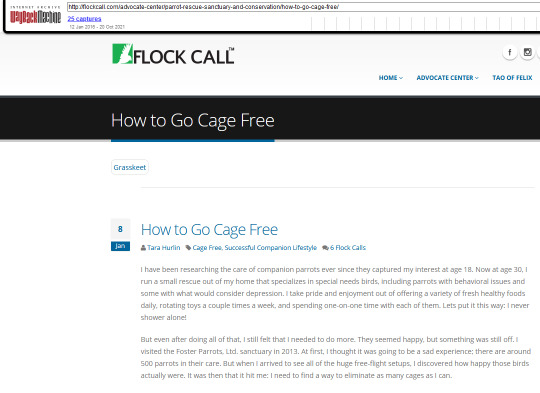
I was browsing my bookmarks, and found a good one that I didn't remember... and that turned out to be gone. I ran it through the Wayback Machine, and turns out the site has been down for a few years.
So, for my own sake and for posterity, I am posting it here, because it is useful information.
How to Go Cage Free
Tara Hurlin
I have been researching the care of companion parrots ever since they captured my interest at age 18. Now at age 30, I run a small rescue out of my home that specializes in special needs birds, including parrots with behavioral issues and some with what would consider depression. I take pride and enjoyment out of offering a variety of fresh healthy foods daily, rotating toys a couple times a week, and spending one-on-one time with each of them. Lets put it this way: I never shower alone!
But even after doing all of that, I still felt that I needed to do more. They seemed happy, but something was still off. I visited the Foster Parrots, Ltd. sanctuary in 2013. At first, I thought it was going to be a sad experience; there are around 500 parrots in their care. But when I arrived to see all of the huge free-flight setups, I discovered how happy those birds actually were. It was then that it hit me: I need to find a way to eliminate as many cages as I can.
Even if they are born in captivity, parrots are wild at heart. They are not domesticated animals; their brains are not wired for life in a cage. Depending on the bird, some think of their cage as a safe place to go to sleep and eat, but others act out, get depressed or start feather picking from boredom. The huge, most important part to consider when thinking about going cage free is (pay attention): You must know your bird, and if you have a flock, you absolutely must know your flock.
It took about a year for my rescue, Hurlin’s Parrot Rescue, to convert to going mostly cage free, and we are still changing things weekly. Keep in mind that we have a flock of 20, and it is a slow process because I allowed everyone to adjust at their own pace. In the beginning, I built jungle gyms hanging from the ceiling out of untreated manila rope. I hung a variety of toys, and they used that as a supervised playtime area – supervised so I could learn who may get along with who, or who was going to be a issue with other birds. As an important note: The large birds such as the Macaws are always kept in separate rooms, the Cockatoos in another separate room, and then the Amazons and African Greys in another.
The next step was to add large hanging perches made out of bird safe woods such as poplar, maple, untreated but de-barked pine, and Manzanita wood. It is important to hang all items with either stainless steel chain or plastic chain, depending on your birds (many will chew plastic chain). I installed dishes directly to the stands and hung toys from the chain so they could reach them. Who got to try out their cage free setup first was based upon each individual’s behavior during the supervised playtime trials. For example, I started with the more shy birds that would need more time to establish their territory, let them get situated, then moved on to the Timneh African Greys who had already established their flock. All the while, I routinely weighed each bird to make sure they were maintaining their weight and not losing due to any stress that may be associated with the big changes. My flock personally had no weight concerns during the transition, but better safe than sorry.
[missing image] When choosing your chain, also make sure that it is safe for little birdie feet. There are certain types known to trap toes.
Meanwhile in the Macaw room, I hung all five of their ceiling play stands in the same day and moved the cages out. Shower curtains were also hung on the walls to assist in their giant poops and food flinging. I did this transition more suddenly because everyone was already used to each other; most had been in the same room for over a year. There is one handicapped Green wing Macaw in this flock, Paco, whose feet were so badly injured that they are paralyzed. Even she is cage-free: I made a play stand that works for her from hula-hoops wrapped in fleece fabric. This works wonderfully, since she is unable to climb or perch, she would just sit in the bottom of a cage all day and crawl through any poop. I had to wash her blankets and bathe her daily. Now she just aims her butt off of the play stand and poops on the papers like everyone else, usually with a little happy dance afterwards!
[missing image] Even handicapped birds have the potential to live cage free, like Paco the Green Wing Macaw.
During the transition, only a few problems occurred: My Scarlet Macaw, Booboo, who is normally a high-anxiety bundle of nerves and plucks herself accordingly, did pluck her feathers during the first week of the change. Aside from being more nervous than usual, she otherwise seemed happier than normal and in bright spirits, and even began to play with toys – something I never saw her do before. She has now fully adjusted and stopped plucking (until another hormone season comes around, most likely).
There are four birds who unfortunately can never be cage-free, but I found this out in the very beginning during supervised play times. One is our male Eclectus, who puts a lot of effort into chasing down the Amazons, and in turn his friend Velvet also cannot be cage free, because she will find a dark corner and get “nesty”, which is something that we avoid here. The Eclectus species also has different dietary needs. Another caged bird is Toby, our “hot” yellow-nape Amazon, but that was common sense and expected, as he is highly hormonal to the point of unpredictable attacks. And the fourth is Buddy the Red Lory for obvious reasons: he’s a completely different species with different dietary needs, and he is a little guy that could easily get hurt.
About three-to-four months after switching to cage free, there is one bird in particular, Spooky the Timneh African Grey, who began to claim to entire room as his territory and bully the other birds, so as a precaution he maintains a cage while we are not home, but the door is opened at all times when we are home. His setup may or may not go back to cage free again in the future. This is a great example of how flock dynamic can change over time, and you as the caretaker have to be prepared to make any changes that come with it. For me, that was regretfully adding one more cage to the bird room, making five cages total – not bad at all if you consider the flock of 20.
I often get the question of “what if a bird gets adopted, or needs to join the flock?” Similar steps will be taken if another bird is relinquished to our rescue and has the possibility of going cage free. Of course, we maintain our quarantine procedures; our quarantine room is an entirely separate room from any of the other bird rooms. Then, once we are positive the new bird is healthy, he or she is brought into the bird room in a cage to gage reactions from the flock and the newbie. From there, the new bird can move to an open-cage status, then possibly cage free. It is important to note that the majority of birds that are easily adoptable into approved homes will not transition to our cage-free flock. This will avoid stress on them if they find a new family, and it will prevent stress on our own flock. With every bird that comes and goes, the flock is affected and the dynamic changes. We take the time to get to know each bird before making any decisions – as much time as it takes. It is our responsibility to do what is in the individual’s best interest, and for our existing flock.
As for maintaining the cage free setup, new toys, swings, boings and other perches are hung and changed out regularly to keep everyone busy. Most of the birds are flighted and will explore the room, but they always return to their “safe spot” on their own play stands for food, water or sleep (with the exception of a few that prefer sleeping up on the ropes).
[missing image] It's important to keep your flock busy by adding random foraging areas and rotating toys.
I wish that I could tell everyone that eliminating cages was all sunshine and rainbows – a piece of cake – but it takes a lot of thought and even more work! It may not be for every flock, and I can’t make that decision for you because only you can truly know your birds. Only you know what your setup is capable of and what is realistic for you.
What I can say is that I have no regrets. I have never seen my birds happier. The sparkle in their eyes shines brighter; they chatter more and interact with each other more, even just vocally from across the room. The vibe in the room is much more lively and happy, and I no longer feel the guilt of seeing so many cages lined up around the walls like little jail cells. A few birds in particular have completely turned around: for example, Ariel, a bird who was locked in a cage for ten years and very difficult to handle due to her mood swings (I self-diagnosed her as being bipolar with possible depression), now constantly asks for me to hold her and accepts preening, almost to the point of cuddling. The first time she did this is a moment I will never forget; it was the kind of moment that reminds a rescuer why they rescue in the first place. Tears of joy filled my eyes. Another change happened in my African Greys, Shelby and Remy. With the cage-free setup they go wherever they please, and that often involves following me wherever I am in the house, which is something I love. They fly back down to their rooms when they decide it is bedtime. Their confidence has become higher from having that independence.
[missing image] Ariel is a more emotionally stable bird after going cage free.
Another perk for me personally, aside from the happy aura radiating throughout my bird rooms, is that this setup is very low maintenance compared to having cages. I spend less time scrubbing cages bars and bottom grates, which means I can enjoy more time interacting with the flock. What used to take a full day to clean now only takes a couple of hours – and that is a full on OCD bird room scrub down. We have leftover rolls of 48” wide paper donated by our local newspaper distributor. The paper is cut into large sections to completely cover the floors in each room. Smaller sections are laid over the main paper for the extra poopy spots for ease of changing it, and it makes the larger portion last longer. I sweep daily, and I wipe the walls and change papers in their entirety a couple times per week.
[missing image] Be prepared to sacrifice your wood trim... And doors!
I still continue to make changes to the bird rooms, and this will be an ongoing thing. Another large phase that will take place in spring/early summer 2016 is switching out all of the wood trim for tile or stainless – whichever I find the most cost effective (or the least ugly). Lucky for the flock, I didn’t care for the wood trim we had in those rooms, anyway!
[missing image] A glimpse of the mostly cage-free setup. Buddy the Red Lory's cage is to the left, and to the right (not pictured) are the other two cages for Velvet and Shifu, and Toby.
[missing image] Another shot of the same bird room showing the other two cages. An air filter and backup heat (vented to the outside) is also in the photo.
Main Points for going cage free:
Know your birds.
Be patient and observant.
Weigh your birds regularly to make sure they are maintaining weight and health.
Be prepared to make changes as flock dynamics change.
Adjust with the flock; you are part of it.
You better not care about your trim or possible furniture in the room, or have plans to change to un-munchable trim, like tile.
Keep them busy by changing out perches, toys and foraging activities. It’s like having a caged setup, but on a larger scale with no bars, so you have to get creative.
Enjoy watching your flock be a flock, and take pride in being part of it.
5 notes
·
View notes
Note
Hi, i’ve been looking at your post, talking about it, and sharing it with some friends. Honestly i’d even say i’m a fan of you and your work despite how little of it there is right now. I have a couple question.
First, I was wondering if you had any other accounts that I could follow your work on, like twitter and such.
Second, I saw that you took classes in etholgy and talked about advocating for the personhood of animals. I mean, I know they’re smarter than we sometimes give them credit for. Take for example the recent study with scientist communicating with whales with their own language for the first time. But I was hoping to get your insight in what you mean by personhood of animals and thoughts on the topic. (And also table napkin thought on how anthropomorphizing can harm or help our understanding of animals)
Third but a little more obscure, is that you use humanity, personhood, and the being of « more human » a lot. I was hoping if you could expand on the differences of these terms and how they interact with one another.
Sorry for all the questions, just honest to god fascinated with your perspective of things and the topic in general.
Here’s the whale communication study I mentioned: https://globalnews.ca/news/10182116/humpback-whale-conversation-talking-to-aliens/amp/
Oh my gosh thank you so much for your kind words! This, AO3, and YouTube are actually my only accounts online that I post anything on, and I just use my YT account to reupload other people's deleted videos. I used to use Reddit but I'm trying to distance myself from that account since half a decade of hot take type comments starting when I was 15 isn't exactly the best look for anyone.
Your last two questions are linked so I'm going to address them at once. Human is simply the term used to refer to a member of the genus Homo. There's nothing all that special about it philosophically when separated from personhood, which is more or less the description of what beings do and don't fully matter morally. Speculative fiction and philosophy tend to equate it with sapience, which is more or less a meaningless term made up to separate humans (or worse, specific groups of humans) from other animals and make ourselves feel superior. There have been attempts to give it meaning, but nearly every definition uses traits that are found in at least one other species of animal and/or are not universal to every group of humans (with the notable exception of artistry but I frankly find it absurd to discount something's moral worth over that). As such, if we're going to approach the topic logically, then some animals at the very least have traits of personhood.
Language, for example, isn't exactly common in animals, but it isn't unheard of either. Bats, cetaceans (whales and dolphins), pinnipeds (seals and sea lions), elephants, songbirds (a group that contains crows btw), hummingbirds, and of course parrots all learn different "words" that they apply meaning to and then use. Cetaceans, parrots, and some songbirds even use something akin to grammar.
Ritual behavior has been shown in chimpanzees, dolphins, and elephants as they grieve for their dead.
Self-awareness, the trait most commonly held up as making humans special, is hard to measure due to the language barrier, but there is still some evidence for it in certain animals. The mirror test isn't perfect when it comes to discounting a given animal's self-awareness, but if an animal can identify itself in a mirror, it's hard to argue with the idea that it has a sense of self. Animals that passed include various dolphins, great apes, elephants, magpies, and even certain fish. Furthermore, an African grey parrot named Alex once asked a question about himself, being the first recorded instance of an animal asking anything, and bottlenose dolphins use names for themselves and others in their pod.
I could go on and on, but I think you get the point. I don't really have a definitive list of animals that I believe should be considered "people", especially given all the legal implications of that sentiment, but you've probably noticed that same groups of animals showed up again and again. Dolphins were there in all of the different categories, and elephants only failed the grammar category because they largely communicate using vibrations which work so differently from regular sound that they're hard to meaningfully compare to human languages. Parrots, corvids (crows and relatives), and great apes all have stand out members that showed up in two or three of the categories in the African grey, magpie, and chimpanzee respectively, and the other members of those families as well as whales are all intelligent and social enough that I am of the opinion that they all deserve certain philosophical rights and even legal protections. It's so easy for us to see personhood as a black and white thing that something either has or doesn't have, but like most things, it really is more of a spectrum.
To answer your "table napkin thought", while I won't deny that anthropomorphizing real animals can often lead to a lack of true understanding of them, the harm done by people trying to avoid doing so is both more common and so, so much more horrific that I hesitate to critique it too much. I mean, I have straight up seen very influential people say that acknowledging the extremely well supported fact that other animals are capable of feeling pain is "anthropomorphizing" them because one specific area of the brain that is partially responsible for processing pain in humans is only present in primates, and that of course can, and historically has, lead to horrific abuse.
I really don't mind all the questions! I love talking about things I'm passionate about, and this topic is certainly up there among the the things I care most about.
3 notes
·
View notes
Text
15 Questions For The Writer

1. Are you named after anyone? Nope.
2. When was the last time you cried? Day before yesterday. Got some really bad about a YouTube I follow about Snake content named Brian Barczyk who is fighting cancer. Really heart wrenching 💔 😢
3. Do you have kids? Not unless you count too snakes as children.
4. Do you use sarcasm a lot? Yes, but not maliciously. I always make sure people know when I'm being sarcastic too.
5. What’s the first thing you notice about people? Stature/How they carry themselves and their body language. I'm very introverted so I watch and listen before I ever engage and so I typically see body behavior first.
6. What’s your eye colour? Blue-grey
7. Scary movies or happy endings? Both. I've a fondness for horror from my childhood but I also like a happy ending.
8. Any special talents? I can sew, I'm an artist that can draw decent enough. I was decent singing and music skills. I have a few others that I won't list here too because the internet.
9. Where were you born? Tacoma, Washington in the USA.
11. Have you any pets? Two snakes. One you see me post every so often. I also have several others I have laid to rest over the years that I love dearly to this day. They included: 2 dogs, 3 cats, a parrot, 5 rats (ironically my first rat WAS named Sparky) and a savannah monitor lizard.
12. What sport do you play/have played? I actually hate most sports. The only ones I have ever enjoyed were Boxing, MMA and Wrestling and only as a participant, watching has always been boring to me. I recently have gotten into Iaido, Kendo and Kobudo.
13. How tall are you? 5"4
14. Favourite subject in school? Art, though Drama, Choir, Japanese and History are close behind.
15. Dream job? Comic/Manga artist. It has been a dream I had for a very long time. It isn't about the money or influence or anything, but more about my love of the medium and how it combines drawing and storytelling. It also has a deeper meaning to me that is more personal, so while I don't think I'm good enough to be a Comic artist, it will always be my dream.
tagging: @nebula-drcams @pick-and-shovel-laborer @emptypassicn @heedingcalls @thcsevoices and anyone else that wants to steal this.
tagged by: @therealdarkwingduck
2 notes
·
View notes
Text
A small tip of perspective for those that struggle to navigate their own needs but are animal lovers / pet parents, try to approach yourself and your needs (and for systems, parts and system needs) as if you were trying to understand a specific needs profile of a breed / version of the pet aren't the most aware of and don't have the ability to look up. I don't know how well this applies to non-dog/bird species, but largely in birds and dogs, there is a large variety of needs depending on the species / breed you get and even within species and breeds. What one needs is going to be drastically different from the other
What sort of enrichment is necessary to make this animal happy and able to live to the most of their natural behavioral capabilities? What sort of social exposure and activity does this animal need to meet their needs and make sure they have an enriched life? What have they been eating? Has it been one same meal over and over again beyond the point of enjoying it still? When was the last time things were changed up? When was the last time they were bathed or given the opportunity to see something new?
Largely our system is a bird, and like any bird, you really can't keep them in a cage all day so we have system rules that we should try to leave the house every day for at least an hour and preferably go somewhere that has something to look at that we haven't done in a while. We call this the "Fly the Coop" time and its just a general welfare rule. Treat the bird in our brain like the bird it is and give it it's "outside time" because not giving a bird that would be very bad for them.
We also are a parrot to be specific so it is very important to give us something to work on, a puzzle to figure out, and active mental stimuli and enrichment. We have a very high curious and drive to learn and figure things out, so like any particularly curious parrot, its important to lay out a number of activities, problems, and puzzles for us to figure out and build on - as a result it is important for us to always have a list of skills and problem solving and creation related things availible for us to engage with.
We are also very social but we aren't so much the active cuddler (save for specific parts) and active affectionate type, so much as we are more around the ways of an African Grey or Cockatiel that needs passive company and benefits from a mutually engaged environment; so it is important to have people (or birds for our case as it fills the need) around us doing their own thing and even better if they are also engaged as it lets us relax in an engaged state. Mutual engagement is one of the solid bonding activities. Additionally, we fill our social needs often in the form of social bathing, social eating, and general social cleaning / preening, so when possible, its good to put ourselves in environments where others are doing similar and/or bring our close people and our birds into those activities with us.
Routine is highly important to us as well which again is a good parallel to parrots so we keep that in mind.
With the general frame work, we can really easily apply a mental check list / needs list by largely applying a "welfare and needs" marker for a "non-existant parrot" and apply that to ourselves so rather than trying to figure out what "We Need", we can just make sure we have made sure the parrot need profile in our head has been met.
Largely following the general caresheet for the specific type of parrot that we are has honestly led to a lot better self care and day to day management of our mental, psychological, and physical health so its a perspective thing I do recommend.
11 notes
·
View notes